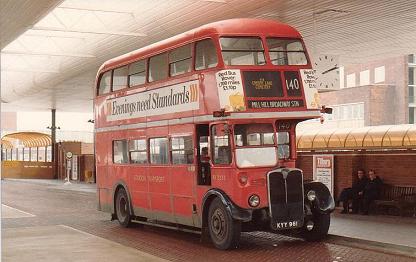Dating originally from 1920, when it ran
between South Harrow and Stanmore, the 140 had a chequered history
of operation in the Harrow and Edgware area until withdrawal in
1927.
Re-introduced in a new form in 1932 to
run from Colindale via Kenton and Harrow to Northolt, the route was
augmented in its first summer to serve the RAF displays at Hendon
Aerodrome. Major changes to the route have been
infrequent. The first was in 1936, when the route was
diverted at Kenton away from Colindale to run north then east to
Mill Hill, terminating at Bunns Lane, short of the low bridge at
Mill Hill Broadway.
Apart from its first few months, when the
route was operated by Willesden garage, the route has worked
continuously from Harrow Weald (HD) to the present day, with the
exception of the period 1990 to 1999 when the contract was held by
London United at Hounslow. Other garages have assisted from
time to time, including Hendon (AE), Edgware (EW) and Willesden
(AC) again.
 Initial operation was by STs, briefly alongside STLs
from AC during the mid-30s, with STLs taking over fully in
1939. In 1950 the 140, with the 114, was an early RTW route
before these 8-footers took their rightful place in central London;
their transfer during 1951 brought RTs from HD and RTLs from EW,
the latter in turn replaced by RTs the following year. Having
been originally planned for 1962 but deflected by union opposition,
Routemasters did not arrive at HD until July 1978, when the RTs
were replaced. They had worked the 140 from AE on Sundays
since 1972, and lasted for a further five years.
Initial operation was by STs, briefly alongside STLs
from AC during the mid-30s, with STLs taking over fully in
1939. In 1950 the 140, with the 114, was an early RTW route
before these 8-footers took their rightful place in central London;
their transfer during 1951 brought RTs from HD and RTLs from EW,
the latter in turn replaced by RTs the following year. Having
been originally planned for 1962 but deflected by union opposition,
Routemasters did not arrive at HD until July 1978, when the RTs
were replaced. They had worked the 140 from AE on Sundays
since 1972, and lasted for a further five years.
Meanwhile, the route extended further south, to Hayes in 1937
and Heathrow Airport (then 'London Airport Central') in 1955.
With the lowering of the road under the railway at Mill Hill, some
Monday to Friday journeys were extended eastwards in 1967, to Page
Street, and again in 1968, to Mill Hill East.
Between 1972 and 1990, two
Sunday afternoon journeys were diverted to serve Cherry Lane
Cemetery (now only served by school bus 698) and were much loved by
enthusiasts. This is another survivor, RT3232 now being
operated by Ensign in their blue and silver livery. It does
seem that most HD RTs were rather dented by the end of their
days. Is the grey 'skirt' a precursor of later
liveries?
On conversion to one-man operation
in 1983, the route was diverted at Harrow to run to Harrow Weald,
swapping the eastward section with the 114, which provides the
service today. The 140 from Heathrow to Harrow Weald has
continued broadly unchanged since; the route is now operated from
HD by Metroline.